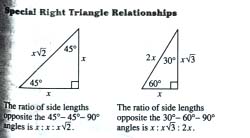
m<C=90
Notes: Applications of the Pythagorean Theorem and Special Right Triangles
Review from previous day:
Pythagorean Theorem
In a right triangle, the square of the length of the hypotenuse
equals the sum of the squares of the lengths of the legs.

m<C=90
a^2+b^2=c^2
Here are some examples of word problems that apply the Pythagorean
Theorem:
Example 1
A power company employee is going to run a power line from the power pole to the back of Joel's house. Use the drawing below, and determine the approximate length of cable the employee will need.

Solution
c^2=a^2+b^2
c^2=(64)^2+(77)^2
c^2=4,096+5,929
c^2=10,025
c=![]()
So c is approximately 100.
Example 2
The length of a rectangle is 24 cm and the width is 10 cm.
How long is the diagonal?
Solution
a^2+b^2=c^2
(10)^2+(24)^2=c^2
100+576= c^2
676= c^2
c= ![]()
c=26
45-45-90 Triangles
A 45-45-90 triangle is an example of a special right triangle. An isosceles right triangle which
means it has two sides of equal length and a 90 angle, has two 45 angles and is called a 45-45-90
triangle. Since we know two sides of the triangle are equal then we also know that the angles
opposite them are equal. You can find the length of the hypotenuse of a 45-45-90 triangle when
the length of a leg is known. Here is a theorem that states
how to do this:
The Pythagorean Theorem, which applies to all right triangles, is used to prove the relationships that exist in the 45-45-90 triangle.

Given: Triangle ABC is a 45-45-90 triangle.
Prove: ![]()
Proof: Triangle ABC is a 45-45-90 triangle.
Using the Pythagorean Theorem, a^2+a^2=c^2.
Simplifying, it follows that c^2=2a^2, ![]()
Here is an example of a 45-45-90 triangle problem:
Example 3
Find the value of c.

Solution
![]()
![]()
Example 4
Find the length of the diagonal of a square with side length 12 cm.
Solution
![]()
![]()
30-60-90 Triangles
A 30-60-90 triangle is another example of a special right triangle that has a 30 degree angle and a
60 degree angle. "The hypotenuse and the longer leg in a 30-60-90 triangle can be found when the
shorter leg is known. The shorter leg is opposite the 30 angle and the longer leg is opposite the 60
angle" (Addison-Wesley Geometry, 313). Here is a theorem that allows you to find the length of
the hypotenuse and the longer leg when the length of the shorter
leg is known:
30-60-90 Triangle Theorem
In a 30-60-90 triangle, the length of the hypotenuse is 2 times
the length of the shorter leg and the length of the longer leg
is ![]() times the length of the shorter
leg.
times the length of the shorter
leg.
The Pythagorean Theorem can again be used to prove the 30-60-90 Triangle Theorem.
Given: Triangle ABC is a 30-60-90 triangle.
Prove: c=2a, ![]()

Draw triangle ADC so that triangle ABC is congruent to triangle ADC. When two triangles are
congruent, their angles are equal. So, m<ADB=60 degrees and m<DAB=30 degrees. Therefore,
all three angles of triangle ABD equal 60 degrees. So, triangle ABD is equilateral and hence, c=2a.
Using the Pythagorean theorem, a^2+b^2=c^2. a^2+b^2=(2a)^2=4a^2.
Thus, b^2=3a^2. We can simplify to get ![]()
Here is an example of a 30-60-90 triangle problem:
Example 5
Find the length of the hypotenuse and the longer leg.
![]()
Solution
Hypotenuse: x=2(6)=12
Longer leg: y=![]()
Example 6
Find the length and diagonal length of the rectangle below.

Solution
Diagonal length: c=2(5)=10
Length: ![]()
Review: Special Right Triangle Relationships
